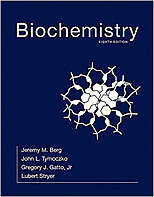
Biochemistry
Berg, Jeremy M.; Tymoczko, John L.; Gatto, Jr., Gregory J.; Stryer, Lubert
8 ed.
New York: W.H. Freeman and Company, 2015
 |
Biochemistry Berg, Jeremy M.; Tymoczko, John L.; Gatto, Jr., Gregory J.; Stryer, Lubert 8 ed. New York: W.H. Freeman and Company, 2015 |
95 termes
| c ring n. |
|
| C4 pathway n. |
|
| Caenorhabditis elegans [nom cientÝfic] |
|
| calnexin n. |
|
| calreticulin n. |
|
| cAMP response element binding n. (CREB) |
|
| cancer therapy n. |
|
| capillary electrophoresis n. |
|
| carbamoyl phosphate synthetase deficiency n. |
|
| carbamoyl phosphate synthetase I n. |
|
| carbamoyl phosphate synthetase II n. |
|
| carbanion intermediate n. |
|
| carbohydrate moiety n. |
|
| carbo-loading n. (super compensation) |
|
| carbon dioxide hydration n. |
|
| carbon fuel n. |
|
| carbon numbering n. |
|
| carbon sugar n. |
|
| carbon-nitrogen bond n. |
|
| carboxyl-terminal tail n. |
|
| cargo protein n. |
|
| catalytic center n. |
|
| catalytic cofactor n. |
|
| catalytic cycle n. |
|
| catalytic power n. |
|
| CCA terminal region n. |
|
| CCK n. (cholecystokinin) |
|
| CCT n. (CTP-phosphocholine cytidylyltransferase) |
|
| CD45 n. |
|
| CD8 n. |
|
| cDNA library n. |
|
| cellular energy currency n. |
|
| cell-wall biosynthesis n. |
|
| ceramide metabolism n. |
|
| cGMP-gated ion channel n. |
|
| Chanarin-Dorfman syndrome n. |
|
| chemically synthesized DNA linker n. |
|
| Cheng-Prusoff equation n. |
|
| CheY n. |
|
| CheZ n. |
|
| Chlorobium thiosulfatophilum [nom cientÝfic] |
|
| cholera toxin n. (choleragen) |
|
| choleragen n. (cholera toxin) |
|
| cholesterol metabolism n. |
|
| cholesterol synthesis n. |
|
| chromatin-remodeling complex n. |
|
| chylomicron remnant n. |
|
| cis configuration n. |
|
| citryl CoA n. (citryl coenzyme A) |
|
| CJD n. (Creutzfeldt-Jakob disease) |
|
| clathrin-coated pit n. |
|
| cleaved DNA n. |
|
| closed promoter complex n. |
|
| Clostridium perfringens [nom cientÝfic] |
|
| cobalt atom n. |
|
| coding sequence n. |
|
| combinatorial association n. |
|
| compact molecule n. |
|
| competitive inhibitor n. |
|
| complementary sequence n. |
|
| complete oxidation n. |
|
| complex assembly n. |
|
| component strand n. |
|
| condensing enzyme n. |
|
| cone receptor n. |
|
| conformation selection n. |
|
| conjugation reaction n. |
|
| conserved region n. |
|
| constitutional isomer n. |
|
| constitutive expression n. |
|
| contact distance n. |
|
| cooperative structure n. |
|
| COP n. (coat protein) |
|
| copper ion n. |
|
| Coulomb energy n. |
|
| coupling transcription n. |
|
| covalent enzyme-bound intermediate n. |
|
| covalent insertion n. |
|
| covalent structure n. |
|
| Crassulacea [nom cientÝfic] |
|
| crassulacean acid metabolism n. (CAM) |
|
| CREB n. (cAMP response element binding) |
|
| Cro n. |
|
| cross-peak n. |
|
| CTP-phosphocholine cytidylyltransferase n. (CCT) |
|
| C-type lectin n. |
|
| cyclic photophoshorylation n. |
|
| cystathionase n. |
|
| cystathionine |
|
| cysteine thiyl radical n. |
|
| cytidine triphosphate synthetase n. |
|
| cytidylate n. |
|
| cytochrome b5 n. |
|
| cytochrome bf n. |
|
| cytoplasmic face n. |
|